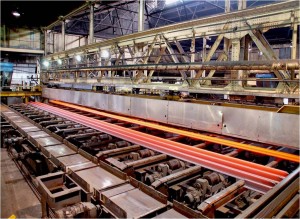
Rail Fabrication Process at ArcelorMittal, Steelton – Image Courtesy of ArcelorMittal
On a daily basis the Metrorail track infrastructure system is subject to the stress and strain of operational and climatic variations. Combining a proactive maintenance program with the latest in rail materials and technology, Metro upholds a commitment to the highest levels of system-wide safety, passenger comfort, operational sustainability, and reliability. System maintenance under the Federal Transit Administration State of Good Repair program has allowed Metro to maintain its commitment to an aggressive “fix it first” policy that features:
“New” Rail is 100% recycled steel – For all replacement rails Metro uses a premium head-hardened rail made from 100% recycled steel. These rails are the highest possible quality available and have the longest possible service life. The rail is fabricated using a controlled water jet system that evenly dissipates heat during the fabrication process to create deep, head-hardened layers through each rail.
Continuously Welded Rail increases system efficiency– Using a state-of-the-art flash-butt welding system Metro has a system-wide program of rail joint elimination to improve ride quality and cut service disruptions. Flash-butt welding applies a strong electrical current to the touching ends of two sections of rail. The ends become white hot due to electrical resistance and can then be fused together to form a single rail. The new continuously welded rail is strong, gives a smoother passenger ride, and allows trains to travel with less friction – thereby increasing system efficiency.
Through Metro’s comprehensive rail-infrastructure maintenance program, upgrades are put in place for the future of the system and transit in the region.
This post forms part of a series featuring content from Metro’s Sustainability Agenda, part of Metro’s Sustainability Initiative.
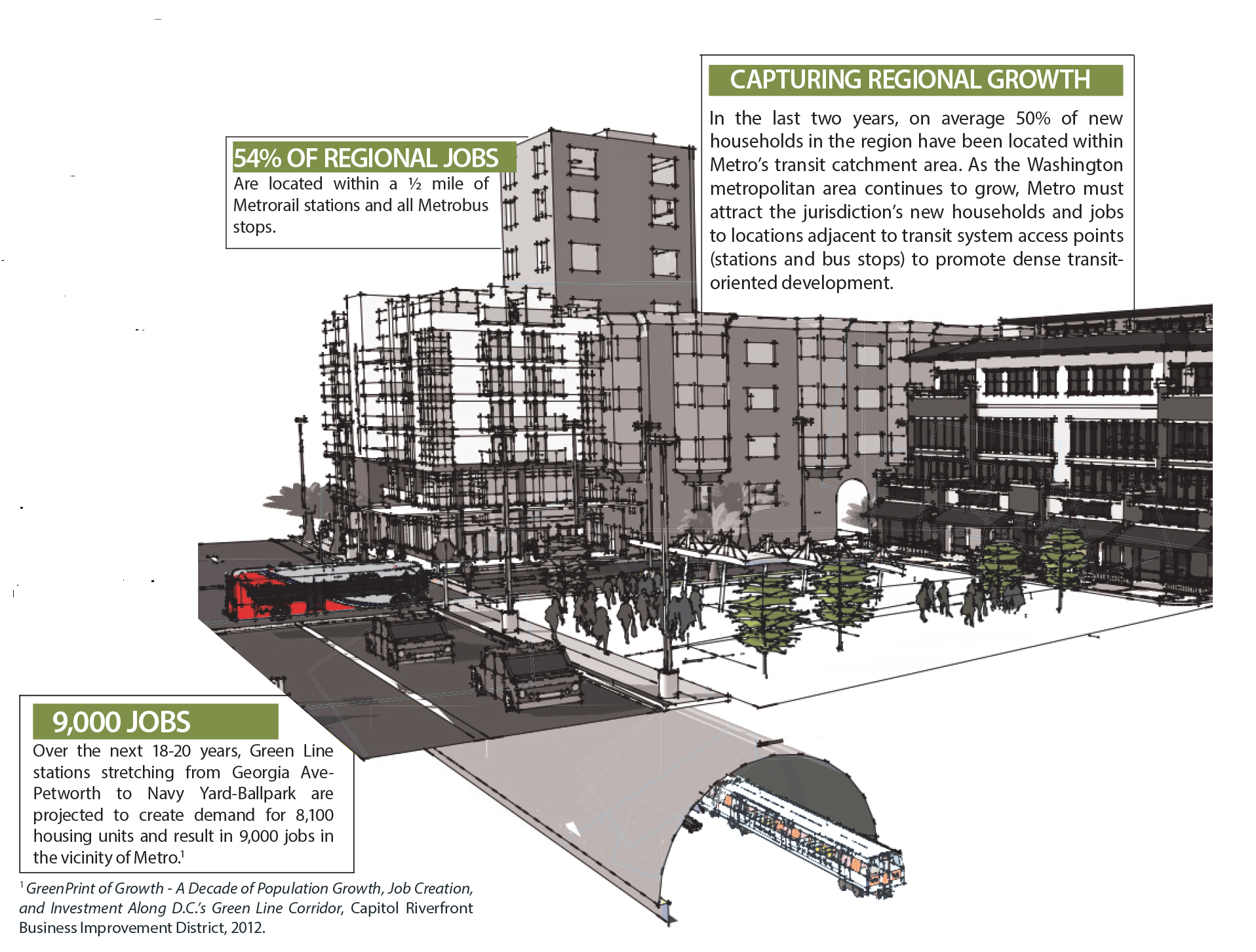
Connecting Communities Concept. Click image for a larger version.
As the Washington metropolitan area continues to grow, the shape of that growth will define the character and sustainability of our region for decades to come. Attracting a significant proportion of the area’s new households and jobs to locations near rail stations and bus stops will provides a host of significant environmental and social benefits that can positively effect quality of life in the region. Quality of life can be improved by convenient access to services via walking, biking, and transit, which reduces road congestion and enables significantly less time to be wasted traveling between destinations via automobile. Compact development also serves to help preserve regional environmental resources such as open space, clean air, and healthy waterways.
- Open Space – By encouraging vertical development on existing underutilized brownfield and greyfield sites, greenfield sites on the urban periphery can be preserved. As and added benefit, this also means that no additional costs are incurred for new road and utility infrastructure to make these new sites viable.
- Clean Air – Reduced mobile emissions from vehicle travel improves local and regional air quality. Just as having cleaner air is important for human health and comfort, it is also important for the world around us. Cleaner air means fewer pollutants in our environment and that means plants, animals, water and soil are healthier too.
- Healthy Waterways – Compact development leaves more land open for stormwater detention and retention on undeveloped land at the urban periphery, thereby reducing the erosive impacts of stormwater runoff on rivers and streams.
One example of how Metro has worked with partners to attract regional infill growth is the NoMa-Gallaudet U station, the first infill station constructed on the Metrorail system. Utilizing what would have been excess capacity on the Red Line, the NoMa neighborhood, anchored by the station, has emerged as a high-density mixed-use hub for residents and commuters alike. Three years before the station opened, the assessed value of real estate in the 35 surrounding blocks was $535 million. Ridership has grown steadily since the station opened in 2004. Three years after the opening (in 2007) it was $2.3 billion — a 330-percent increase. From 2,100 trips in 2005 the station now has an average of 7,400 trips each weekday. Currently, based on the development pipeline data from NoMa BID the neighborhood is approximately 50% built out, with 16 million square feet of commercial and residential space. That is the equivalent of 50 high-density buildings in the 350 acre around the station. In contrast, to accommodate this scale of development in a low-density suburban setting would require in excess of 900 acres and would require new parking and roadway infrastructure due to the absence of transit.
A new Connecting Communities Key Performance Indicator (KPI) (PDF) is being developed to measure regional household growth in areas that are adjacent to Metro. This KPI will be reported through Metro’s Vital Signs Report in 2014.
This post forms part of a series featuring content from Metro’s Sustainability Agenda, part of Metro’s Sustainability Initiative.
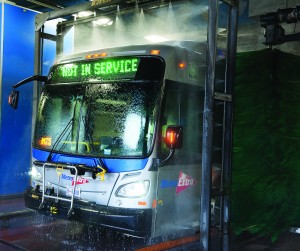
Bus Wash Montgomery Division
Fresh water is a precious resource and Metro is doing its part to reduce strain on shared natural resources and infrastructure. The Authority uses water for a whole host of activities beyond drinking and flushing. Water is used to maintain our facilities, keep stations cool, to wash buses and trains, and to clean vehicle parts. To give Metro’s water use some sense of scale, in 2013 the Authority used 98 million gallons of water, or the equivalent of 148 Olympic-sized swimming pools.
Metro has already made significant investments to conserve water throughout the Authority. For example, all of Metro’s new and renovated bus garages feature bus wash systems that incorporate high efficiency water saving equipment. Wash water is no longer just fed from the utility and mixed with detergents. Instead, during the wash cycle the mix is drained off, transferred to large sumps and then pumped through reclaiming modules of gratings and filters that clean the water that is then reused in the following wash cycles. The bus wash system automatically calibrates not only water usage but detergent application amounts; saving on detergent use as well. The use of high efficient bus wash systems reduces the amount of potable water Metro uses and the amount of wastewater Metro generates.
Also, all new Metro facility construction and major retrofits are Leadership in Energy and Environmental Design (LEED) certified and feature low-flow water fixture upgrades. Low-flow fixtures use high pressure and aeration to produce an acceptable flow without using as much water.
Future facilities, including Metro’s Cinder Bed Road Bus Operations and Maintenance Facility – anticipated to be completed in 2016 – will be designed to LEED specifications and will feature many of the sustainable design features including the efficient bus wash system and low-flow fixtures.
To expand water conservation in the future the Authority has set a target to reduce our potable water use per vehicle mile by 20% by 2025.
This post forms part of a series featuring content from Metro’s Sustainability Agenda, part of Metro’s Sustainability Initiative.
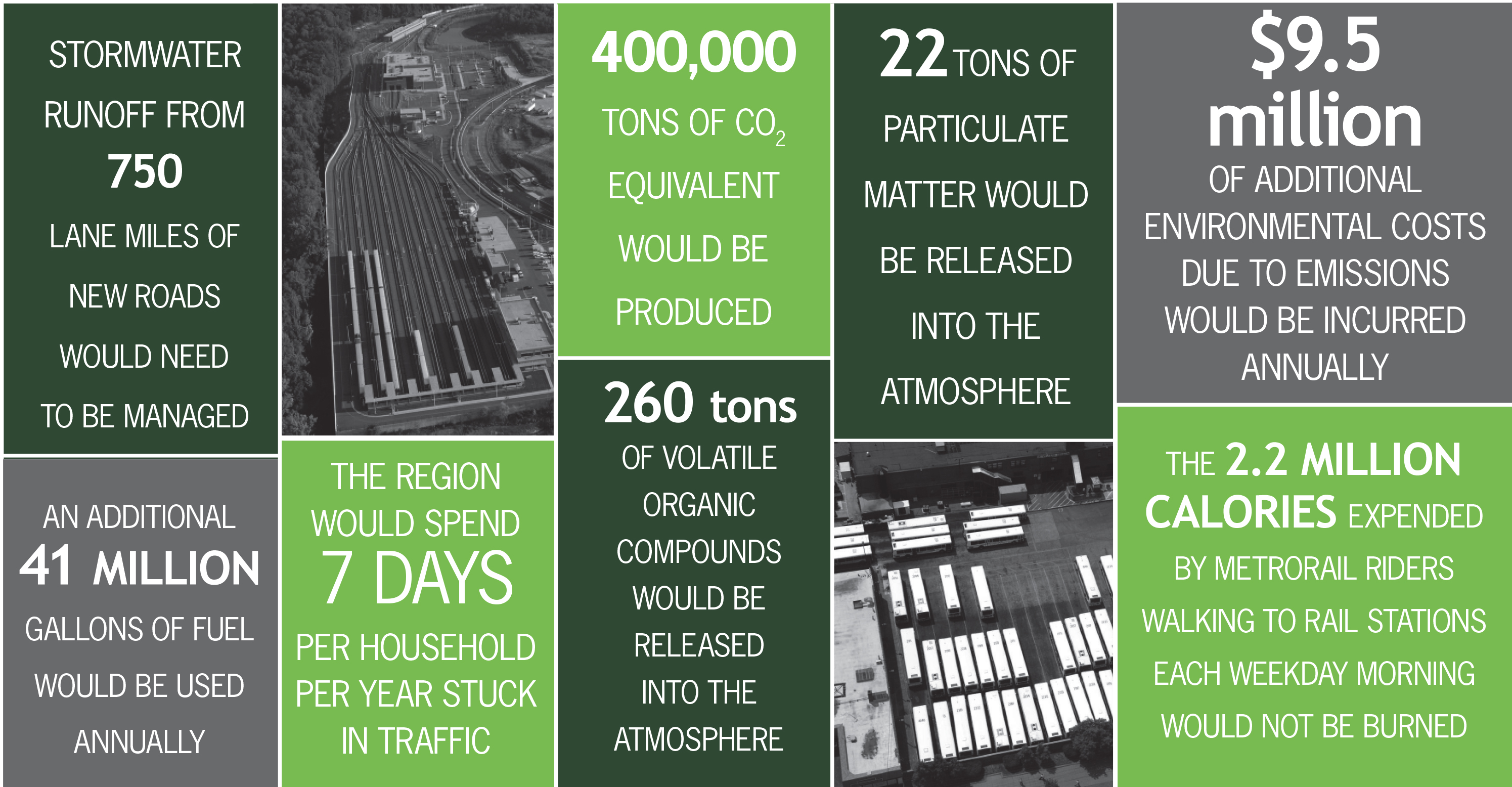
Environmental Impacts of Life Without Metro. Click for larger version.
Every time you ride Metrorail or Metrobus you make a positive impact on the region’s environment. As you can see, those positive impacts extend from the regions rivers and streams right through to the air we breathe every day. For example, without Metro:
- Stormwater runoff from 750 lane miles of new roads would need to be managed
- An additional 41 million gallons of fuel would be used annually
- The region would spend 7 days per household per year stuck in traffic
- 400,000 tons of CO2 equivalent would be produced
- 260 tons of volatile organic compounds would be released into the atmosphere
- 22 tons of particulate matter would be released into the atmosphere
- $9.5 million of additional environmental costs due to emissions would be incurred annually
- The 2.2 million calories expended by Metrorail riders walking to rail stations each weekday morning would not be burned
In particular, the positive impacts on air quality become increasingly important during the summer months when harmful ozone levels are at their highest. When it’s hot and sunny, volatile organic compounds (VOCs) from vehicle emissions react and produce low-level ozone that dramatically reduces air quality precisely when the weather is good and people are outside taking advantage of this. So with summer around the corner taking Metro never made more sense. To see some more detail on the environmental value of transit and Metro to the region check out the details here Making the Case for Transit: WMATA Regional Benefits of Transit Report.
This post forms part of a series featuring content from Metro’s Sustainability Agenda, part of Metro’s Sustainability Initiative.
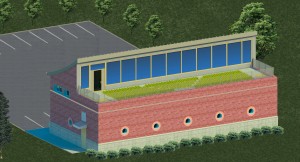
Net Zero Water Treatment Facility
Near the Largo Town Center Metrorail Station, Metro is constructing a water treatment facility that features a modular green roof system and rain garden to filter stormwater. The facility will manage subsurface water from the track bed and has been designed with photovoltaic panels and battery storage system to achieve net zero energy specifications. Designing the facility to net zero means the building will produce as much energy as it needs on-site, without drawing power from the electric grid, to perform the entire subsurface water treatment process.
Currently, in accordance with State of Maryland requirements, track bed water at the station is treated to balance acidity and sulfate solids prior to being discharged into the storm sewer system. New regulations require Metro to undertake more comprehensive stormwater treatment to remove also remove iron and suspended solids. Initially, expanding the current underground water treatment facility at the site was considered. However, the existing location did not have sufficient space to allow the new requirements to be met and a new treatment facility was necessary. The new treatment facility will utilize three large submersible pumps to transport the stormwater to the surface for treatment. Pumping the water to the surface presented new process load requirements, but to address these the facility has been designed with a gravity feed system that uses less energy over the life of the project to perform the water treatment process. In addition, the facility also showcases a host of operating cost reducing green building technologies, including: Read more…

Wayside Storage Battery Power System
For more than 20 years, Metro’s rail cars have captured and reused some of the electric energy that would otherwise be wasted when they brake through a process called regenerative braking. This process converts the excess kinetic energy, as the vehicle slows, to electric energy which can be stored and reused for propulsion power. Building on this technology, Metro recently completed tests to capture and utilize even more of the energy during braking through wayside battery storage.
The pilot project tests the energy storage efficiency and return on investment of a wayside Battery Power System (BPS). The BPS uses an innovative nickel-metal hydride battery that is characterized by low internal resistance. As a consequence, the battery can charge and discharge in a matter of seconds, making it perfect for wayside applications where rapid storage and discharge of propulsion power is required. Through this BPS storage system, the kinetic energy that would previously have been dissipated as waste heat can now be productively reused to power railcars and reduce overall energy consumption. Read more…
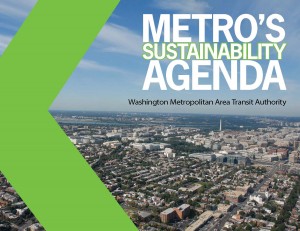
Metro’s Sustainability Agenda
To coincide with today’s Earth Day we are excited to announce the launch of the Metro’s Sustainability Initiative. Last spring Metro’s Board of Directors adopted Momentum, Metro’s strategic plan, committing Metro to sustainability. As a companion to Momentum, Metro’s Sustainability Initiative sets out Metro’s plan to meet that commitment through 2025 and beyond and positions the Authority to enhance regional livability while providing service more efficiently.
Check out Metro’s Sustainability Agenda a publication that highlights Metro’s sustainability investments to date, sets forth regional and internal sustainability performance targets, and outlines future actions that can help meet these targets.
Performance targets include:
- Increasing Metro ridership 25% by 2025
- Increasing greenhouse gas displacement 10% by 2025
- Reducing energy use per vehicle mile 15% by 2025, and cutting in half greenhouse gas emissions per vehicle mile during the same timeframe
- Reducing water use per vehicle mile 20% by 2025
Read more…
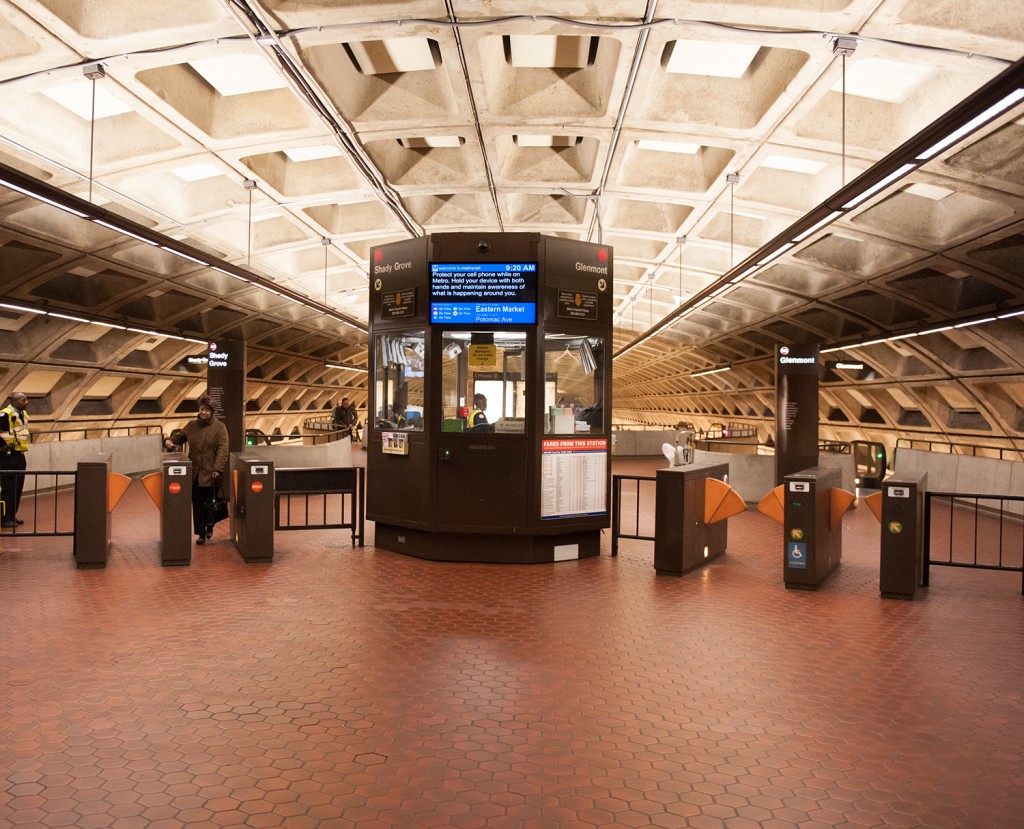
New Station Lighting at Judiciary Square. Click image for larger version.
Pilot upgrades using energy-efficient lighting at three stations have been a success, so Metro is planning to ramp up the effort to 41 more stations by 2015.
Metro recently completed retrofitting the mezzanine-level lights at Judiciary Square, Gallery Place, Bethesda, Smithsonian and Metro Center. Through careful fixture selection, the new fixtures provide a higher quality of light with an improved Color Rendering Index (CRI) thereby improving both lighting levels and overall visibility. Significantly, the new lighting design offers better light levels without compromising the integrity of the original lighting design and station aesthetic. The retrofits also provide significant lifecycle cost savings for Metro through reduced energy consumption and maintenance requirements.
Following these successes, Metro General Manager/CEO Richard Sarles today that it plans to upgrade mezzanine lighting at the 41 remaining underground Metrorail stations by 2015. In addition to the five already completed stations, one station, L’Enfant Plaza is currently under construction. Read more…










Recent Comments